Tiny Molecular Matchmakers
How Salicylhydroxamic Acid Membranes Are Revolutionizing Biomolecule Immobilization
Introduction: Molecular Matchmakers
Imagine trying to arrange microscopic molecules on a surface with precision—getting them to stick in just the right way while keeping them fully functional. This challenge lies at the heart of countless biomedical advances, from rapid disease diagnostics to sophisticated drug screening platforms. At the forefront of this scientific frontier are salicylhydroxamic acid (SHA) functionalized affinity membranes, an ingenious technology that acts like a molecular matchmaker, specifically immobilizing proteins and oligonucleotides with remarkable efficiency.

These specialized membranes represent a significant leap forward from traditional methods, offering scientists unprecedented control over how biological molecules are arranged on surfaces. The secret lies in the unique chemistry between SHA and its molecular partner, phenyldiboronic acid (PDBA)—a pairing that forms stable bonds under various conditions while preserving the biological activity of the immobilized molecules 1 . This technology is already enabling researchers to create more sensitive biosensors, more efficient purification systems, and higher-throughput screening platforms that could accelerate discovery across the life sciences.
The Problem: The Art of Immobilizing Biological Molecules
To appreciate why SHA-functionalized membranes are so revolutionary, we must first understand the challenges scientists face when trying to immobilize biological molecules. Proteins and nucleic acids are not simple building blocks—they're complex, three-dimensional structures whose function depends entirely on their shape and orientation. Traditional immobilization methods often involve:
Covalent Attachment
Creating direct chemical bonds between the molecule and surface, which can distort the protein's structure and impair its function
Non-specific Adsorption
Relying on weak physical forces that often lead to inconsistent orientation and easy detachment
Tag-based Systems
Using biological tags like streptavidin-biotin, which add large, potentially interfering molecular complexes
Each approach presents significant limitations. Meanwhile, non-covalent methods may lack stability, "resulting in leaching of protein off the surface" 1 . The stakes are high because proper immobilization is crucial for so many applications. Diagnostic tests rely on antibodies fixed in positions that preserve their ability to recognize disease markers. Drug screening platforms require enzymes oriented in ways that maintain their catalytic activity. Purification systems depend on specific interactions between immobilized molecules and their targets.
The Solution: A Chemical Affinity System With Perfect Partnership
The SHA-PDBA system developed by Prolinx, Inc. offers an elegant solution to these challenges. This approach leverages the specific interaction between two small synthetic molecules: salicylhydroxamic acid (SHA) and phenyldiboronic acid (PDBA). The system works through a precise molecular recognition process that can be likened to a lock and key mechanism, where PDBA serves as the key that fits perfectly into the SHA lock 1 2 .
Key Advantage
"The complex between PDBA and SHA has been shown to be stable in aqueous solutions that vary widely with respect to pH, salt, and detergent or denaturant concentration" 1 .

What makes this system particularly valuable is its versatility and stability. This robustness makes it amenable for use with diverse biological macromolecules under various experimental conditions.
Perhaps most importantly, this immobilization strategy preserves biological function. Unlike random covalent attachment that can disrupt delicate protein structures, the SHA-PDBA system allows for oriented immobilization. Scientists can first modify their protein of interest with PDBA in solution, where the reagent has full access to the protein's surface and where reaction conditions can be carefully controlled to maintain activity. The resulting PDBA-protein conjugate can then be immobilized directly without purification, significantly simplifying the process 1 .
A Key Experiment: Testing the Membranes' Capabilities
To understand how scientists demonstrated the effectiveness of SHA-functionalized membranes, let's examine a crucial experiment from the research literature 1 .
Methodology: Step-by-Step Process
The research team employed a systematic approach to evaluate their SHA-membranes:
Disks of SHA-functionalized regenerated cellulose membranes (0.45 μm pore size) were cut and fitted into microcentrifuge spin columns.
Various concentrations of PDBA-modified proteins and unmodified controls were passed through the membrane-containing columns via slow centrifugation.
Alkaline phosphatase (AP) and human immunoglobulin G (IgG) were separately modified with PDBA using different molar ratios of Versalinx Amine Modifying Reagent (PDBA-X-NHS) to protein.
Membranes were washed with phosphate-buffered saline, and the flow-through was analyzed for protein concentration and enzymatic activity.
Complementary Approaches
The researchers also employed additional techniques to further characterize their system:
- Dot blotting: Sheets of SHA-membranes were fitted into a dot-blot apparatus and loaded with PDBA-AP or unmodified AP to visualize immobilization.
- Oligonucleotide binding: Radioactively labeled PBA-modified oligonucleotides were tested for binding and release from the membranes.
- Capacity measurements: Multiple concentration points were tested to determine the binding capacity of the membranes.
Data Analysis: What the Experiments Revealed
The experiments generated compelling data demonstrating the effectiveness of the SHA-PDBA immobilization system. Let's examine some key findings through the data tables below.
| Biomolecule | Modification | Binding Capacity | Specificity Ratio (vs. unmodified) |
|---|---|---|---|
| Alkaline phosphatase | PDBA-modified | High (>90% immobilized) | >20:1 |
| Alkaline phosphatase | Unmodified | Low (<5% immobilized) | - |
| Human IgG | PDBA-modified | High (>85% immobilized) | >15:1 |
| Human IgG | Unmodified | Low (<6% immobilized) | - |
| Oligonucleotides | PBA-modified | High (>80% immobilized) | >10:1 |
| Oligonucleotides | Unmodified | Low (<8% immobilized) | - |
| Protein | Release Reagent | Incubation Conditions | Release Efficiency |
|---|---|---|---|
| Alkaline phosphatase | Versalinx Protein Releasing Reagent | 37°C, 30 min | >90% |
| Human IgG | Versalinx Protein Releasing Reagent | 37°C, 30 min | >85% |
| Oligonucleotides | Versalinx Nucleic Acid Releasing Reagent | 37°C, 10 min | >80% |
| Protein | Modification | Activity Retention | Comparison to Solution Activity |
|---|---|---|---|
| Alkaline phosphatase | PDBA-modified | >95% | Full retention |
| Alkaline phosphatase | Unmodified | N/A (minimal binding) | N/A |
| Antibodies (various) | PDBA-modified | >90% | Full antigen recognition |
The data reveals several important advantages of the SHA-PDBA system. First, the modification with PDBA dramatically increases binding to SHA-membranes compared to unmodified proteins, demonstrating the specificity of the interaction 1 . Second, the system allows for efficient release of immobilized molecules under mild conditions, enabling recovery of valuable biomolecules. Most importantly, the immobilized proteins retain their biological activity—a critical advantage over many traditional immobilization methods that often compromise function.
The Scientist's Toolkit: Research Reagent Solutions
To implement this technology, researchers utilize a specific set of reagents and materials. The following table outlines key components of the SHA-PDBA immobilization system and their functions:
| Reagent/Material | Function | Key Features |
|---|---|---|
| SHA-functionalized membranes | Solid support for immobilization | Microporous cellulose, high binding capacity, compatible with standard formats |
| Versalinx Amine Modifying Reagent (PDBA-X-NHS) | Protein modification | Reacts with primary amines, defined stoichiometry |
| Versalinx Protein Releasing Reagent | Release immobilized proteins | Mild conditions, high efficiency |
| Versalinx Nucleic Acid Releasing Reagent | Release immobilized oligonucleotides | Specific for PBA-oligonucleotide complexes |
| PDBA-modified oligonucleotides | Specific binding to SHA-surfaces | Multiple PBA modifications enhance avidity |
Applications: From Laboratory Tools to Medical Solutions
The implications of SHA-functionalized membrane technology extend far beyond basic research. These advanced materials are enabling innovations across multiple fields:
Biosensors and Diagnostic Devices
The precise immobilization offered by SHA-membranes allows creation of highly sensitive detection platforms. Antibodies immobilized via the SHA-PDBA system maintain their ability to recognize disease markers, potentially leading to more accurate diagnostic tests. The stability of the SHA-PDBA complex under various conditions makes these sensors robust enough for real-world applications 1 .
Protein Purification Systems
SHA-membranes can serve as affinity matrices for purification of specific biomolecules. The controlled release mechanism allows for gentle elution of purified proteins without denaturation, maintaining their native structure and function. This application is particularly valuable for producing therapeutic proteins that require high purity 1 .
High-Throughput Screening Platforms
The compatibility of SHA-membranes with microarray formats makes them ideal for drug discovery applications. Pharmaceutical researchers can immobilize thousands of different drug targets on small membrane surfaces and screen them against potential therapeutic compounds. The oriented immobilization ensures that targets are presented in their natural conformation 1 2 .
Environmental Monitoring
The specificity and stability of SHA-PDBA binding can be harnessed to create sensors for environmental contaminants. By immobilizing antibodies or enzymes that recognize specific pollutants, researchers can develop monitoring devices that provide rapid, on-site detection of environmental hazards 1 .
Conclusion: The Future of Biomaterial Design
Salicylhydroxamic acid functionalized affinity membranes represent more than just a technical improvement in immobilization methods—they exemplify a fundamental shift in how scientists approach the interface between biological molecules and synthetic materials. By creating systems that work with rather than against the natural properties of biomolecules, researchers are developing more sophisticated tools for medicine, research, and technology.

The SHA-PDBA system's unique combination of specificity, reversibility, and preservation of biological activity addresses longstanding challenges in biomolecule immobilization. As this technology continues to evolve, we can anticipate even more innovative applications emerging—from advanced drug delivery systems that release therapeutics in response to specific biological signals to synthetic biology applications where precisely organized enzymes create efficient biosynthetic pathways.
Perhaps most exciting is how this technology exemplifies the growing convergence of chemistry, materials science, and biology. As researchers continue to develop increasingly sophisticated methods for controlling molecular interactions, we move closer to a future where we can truly harness the power of biological molecules to address some of humanity's most pressing challenges in health, energy, and environmental sustainability.